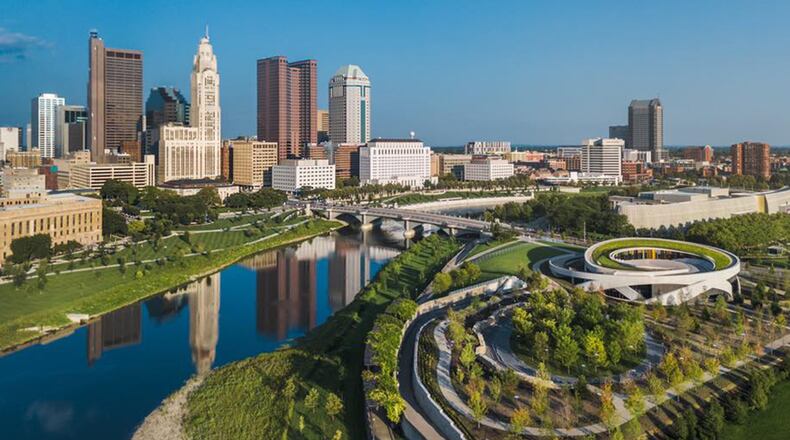“Ever since I was a kid, I was dead set on getting into West Point. I was in the class of 2005. We are considered to be the class of 9/11 because 9/11 happened our freshman year. It got very real when classmates started dying. Every once in a while, they’d make an announcement at lunch that we lost another classmate in combat.”
That poignant recollection is just part of the story of former U.S. Army 1st Lt. Joshua Mantz of San Jose, Calif., a Purple Heart recipient. It’s one of many personal stories that visitors will experience at the new National Veterans Memorial and Museum in Columbus, Ohio, which opened Oct. 27.
They’ll also find out about Deborah Sampson, a teenage girl who disguised herself as a boy to fight in the Revolutionary War. When injured, she dug the musket ball out of her flesh rather than let a doctor discover her secret. And they’ll learn about Army Sgt. Wendell Wiley Wolfenbarger, whose lucky rabbit’s foot and wishbone couldn’t protect him from being killed in action during World War II, and Army Sgt. Don Jakeway, who survived even after confronting nearby German snipers.
War and peace.
Life and death.
Honor and survival.
History and homecoming.
These fundamental themes of human experience are on display, mostly in the form of first-person accounts, at the nation’s first museum dedicated to veterans from all conflicts and all branches of the U.S. military.
“We have museums across the country that focus on branches and conflicts, but our museum houses universal stories of patriotism and service from all branches and all conflicts under one roof,” said retired Army Lt. Gen. Michael Ferriter, the institution’s president and CEO. “The emotional core of the experience lies within the individual stories of each and every one of the people featured throughout the exhibition program.”
The stories represent the more than 40 million veterans — about half of them still alive — from throughout U.S. history, from all five branches of the military, in all conflicts, including those that happened before the 13 colonies became the United States of America.
It’s not just a memorial and museum about the military, it’s about the United States and its place in the world.
More than $82 million was raised through public and private philanthropy for this 53,000-square-foot museum and 2.5-acre memorial grove that sits on 7 acres in downtown Columbus. It uses interactive exhibits and displays with large photographs and numerous video clips to tell these stories.
One of the interactive exhibits is a visually compelling touch screen featuring an image of a parachute. You can select years between 1950 and 2018 and learn the history of the modern military with a few words, some numbers and highlighted maps. Visitors who select 1950, for example, will find out that there were 1.46 million people serving in the military that year, primarily in Japan, Germany and the Panama Canal zone. Tap 1953 next, and you’ll see that the number of troops had increased to 3.5 million people, and Korea was at the top of the list of deployments.
For 2018, that number is 1.3 million people — less than 1 percent of the U.S. population — with the largest numbers serving in Japan, Germany and South Korea.
As you walk through the museum, heading upward through the curved concrete interior, you pass different thematic spaces that feature different parts of the narrative. Among them are “Why We Serve,” “In Combat,” “Transformation” and “Service and Citizenship,” each with its own short film.
The museum, designed by Allied Works Architecture, was named one of the 12 most-anticipated buildings of 2018 by Architectural Digest, which described the building as understated and dignified. Inside, visitors walk through a light-filled spiral processional ending at the top of the building and its rooftop sanctuary, designed for ceremonies and reflection. Outside, across from the building entrance, OLIN landscape architects designed the memorial grove with American elm trees, a curving pathway and a stone wall with three waterfalls filling a reflecting pool.
Ohio native Sen. John Glenn, the Marine pilot and astronaut who died in 2016, was instrumental in planning the ambitious venture. He led the committee that determined the museum’s foundational pillars: honor, connect, inspire and educate — examples of which are found throughout the building.
One of the artifacts at the museum is a presentation sword given in 1852 by Maj. Daniel McCook to his son, Alexander McCook, at his graduation from West Point. More interesting than that gift, though, is the story of the McCook family. More than a dozen of them, cousins and brothers known as the Fighting McCooks, served in the Union Army during the Civil War. Six rose in the ranks to become brigadier generals or higher; five died during the war.
IF YOU GO
The museum, 300 W. Broad St., is open 10 a.m. to 5 p.m. Wednesday to Sunday, or Tuesday to Sunday from Memorial Day to Labor Day. Admission is $17; $12 for veterans.
About the Author
Keep Reading
The Latest
Featured


